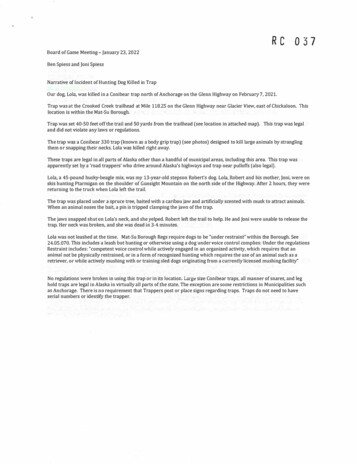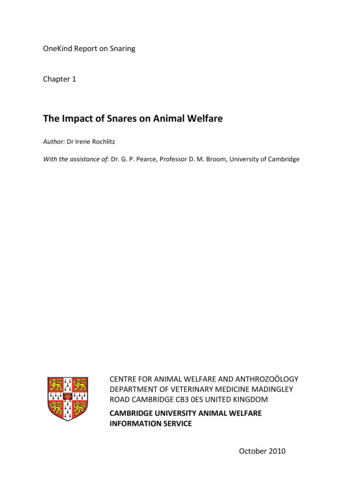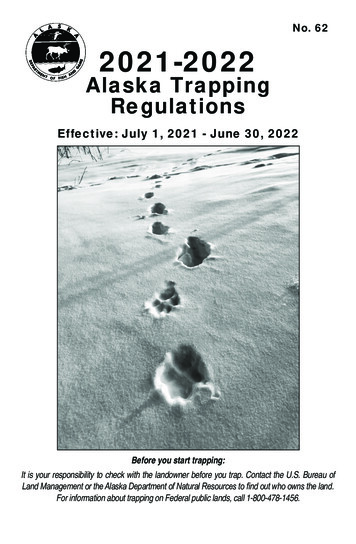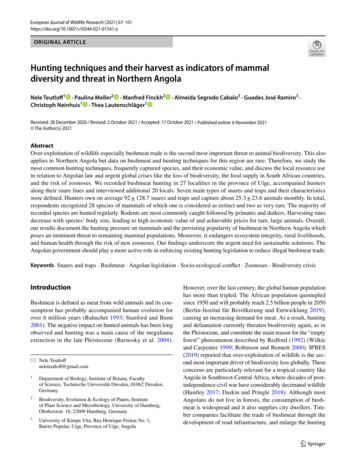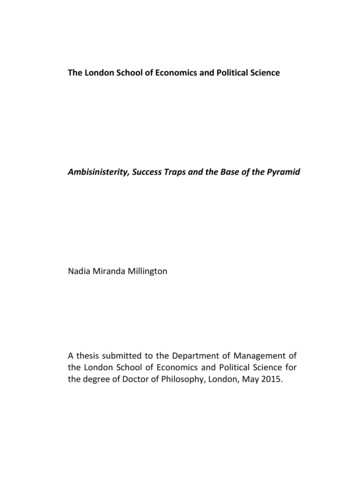
Transcription
The London School of Economics and Political ScienceAmbisinisterity, Success Traps and the Base of the PyramidNadia Miranda MillingtonA thesis submitted to the Department of Management ofthe London School of Economics and Political Science forthe degree of Doctor of Philosophy, London, May 2015.
DeclarationI certify that the thesis I have presented for examination for the PhD degree ofthe London School of Economics and Political Science is solely my own workother than where I have clearly indicated that it is the work of others (in whichcase the extent of any work carried out jointly by me and any other person isclearly identified in it).Parts of this thesis have been redacted in line with a confidentiality agreementbetween LSE, the author and the company on which the case study is based.The copyright of this thesis rests with the author. Quotation from it is permitted,provided that full acknowledgement is made. This thesis may not be reproducedwithout my prior written consent.I warrant that this authorisation does not, to the best of my belief, infringe therights of any third party.I declare that my thesis (without redacted portions) consists of 45,145 wordsincluding footnotes, excluding references and appendicesStatement of use of third party for editorial helpI can confirm that my thesis was copy edited for conventions of language,spelling and grammar by Marie Youssef Smith.2
3
AbstractThe failure to simultaneously explore and exploit (i.e. achieve ambidexterity)continues to present an ongoing challenge for Multinational Corporations(MNCs). Here, exploration involves “experimentation with new alternatives” andexploitation, “refinement and extension of existing competencies, technologiesand paradigms”. This problem is particularly acute for MNCs exploringdisenfranchised/poverty prone segments (such as the Base of the Pyramid),whilst exploiting existing strongholds in wealthier segments of emerging marketcontexts. Yet there continues to be a dearth of academic scholarship on thisphenomenon.This thesis aims to address this gap. It comprises two sections - The first sectionpresents a systematic review of ambidexterity failure literature (referred to asambisinisterity), which is then paired with insights from institutional theory toexamine factors that account for MNC failure, specifically within low munificenceemerging market contexts. The second section investigates one theoreticalperspective within the ambisinisterity tradition, viz. a success trap.Fundamentally, a success trap refers to the tendency of an organisation tooverspecialise in exploitation at the expense of exploration. This thesis examinesthis theory from the countervailing perspective of exploration under-adaptationand draws on a longitudinal inductive qualitative single case study of XXX India’sHealthcare Division to develop theoretical insights.My findings illustrate that exploration under-adaptation in emerging marketsresults from the dynamic interplay of accelerated learning and divergencemechanisms. Should these processes not be constrained and monitored with likerigour, MNC failure to explore in resource-constrained environments willcontinue to confound Top Management Teams.4
Acknowledgments“If the poor [residing at the Base of the Pyramid] are to be givenpriority, then there has to be enough room for an ethical approach toeconomics on the part of those active in the international market andan ethical approach to participation capable of harnessing thecontributions of civil society at local and international levels”(Pope Benedict XVI, 2009).This PhD was the result of tremendous sacrifice and a desire to understand whyone of the most prolific contributions to contemporary management theory,from my perspective (the Base of the Pyramid postulate) continues to result infailure. From inception, this was an uphill battle as there have been few scholarlyworks in this area from a multinational (MNC) perspective. In this regard, I amthankful to Professor Harry Barkema, my supervisor, for his beautiful mind andfor taking this leap of faith with me in the hope that this line of enquiry wouldresult in something useful to say. It was a privilege to learn from you and I cannotthink of a better, more inspiring completer-finisher! I am also thankful to mysecond supervisor, Professor Saul Estrin and Dr. Susan Hill, who started thisjourney with me and to the LSE ASIA Research Centre who funded my firstexploratory trip to India.With respect to India, words cannot express how grateful I am to my adoptivefamilies: Shweta, Kiran and the Sastris, and Vikas and the Chawlas for hostingme, and frankly without whom this PhD on a MNC in India would not be possible.The same goes for my UK and ‘Trini’ extended family: Marie, Maria, Rico, Alana,Ian, Stelios, Jess and Lish – you all supported my crazy life, helped metremendously and have afforded me a great measure of comfort and laughterduring what has been a very arduous process. To my other friends and PhDcolleagues too numerous to mention, who have supported me in one way oranother in this process, thank you. Mention must also be made of Dr. Terrence5
Farrell who was a constant source of inspiration and help when I needed it themost and Maldon Pantin for his prayerful support.Finally, I want to thank my most amazing family: Henry, June, Michael, Michelleand Nicholas for their love and encouragement. There is no greater love thanlaying down your life for someone else, and I thank my parents especially for thegreatest example of what love is. To my sister, Michelle, my biggest cheer leader– thank you for your unwavering support and believing in me to a fault. To mybrother, Michael, I thank you for always being strong, consistent, helpful and foropening your home and sharing your family with me. Many times they have beena source of reprieve in what has been a very hectic period in my life. To mygrandmother, Geneva Adams, I will always remember your sacrifice and love andwill endeavour always to make you proud. And last, but most importantly, Ithank God, with whom all things are possible!6
For my loving parentsHenry Millington & June Millington andmy angel / grandmother Geneva Adamsfor always seeing the surgeon in me!7
Table of ContentsCHAPTER 1:INTRODUCTION. 131.1.BACKGROUND .131.2.RESEARCH OVERVIEW .171.2.1.1.3.AN OUTLINE OF THE EMPIRICAL CHAPTERS . 21THE BOP POSTULATE .24CHAPTER 2:AMBISINISTERITY (AMBIDEXTERITY FAILURE) . 302.1.CHAPTER OVERVIEW .302.2.DEFINING THE PROBLEM .302.3.DEFINING AMBISINISTERITY.322.3.1.THE BALANCE VERSUS THE SYNERGISTIC PERSPECTIVE . 332.4.A REVIEW OF THE RESEARCH ON AMBISINISTERITY .342.5.AMBISINISTERITY IN EMERGING MARKET CONTEXTS .422.5.1.ENVIRONMENTAL FACTORS . 462.5.2.FIRM FACTORS . 532.5.3.LEADERSHIP FACTORS PROCESS-BASED AND COGNITIVE . 562.6.LIMITATIONS .632.7.CONCLUSION .64CHAPTER 3:RECONSTITUTING THE SUCCESS TRAP (EXPLORATION UNDER-ADAPTATION) . 663.1.CHAPTER OVERVIEW .663.2.AN OVERVIEW OF THE RESEARCH DOMAINS.663.3.CONCLUSION .73CHAPTER 4:METHODOLOGY (THE XXX CASE STUDY) . 754.1.CHAPTER OVERVIEW .754.2.RESEARCH DESIGN, SETTING AND RATIONALE .754.2.1.4.3.RESEARCH SETTING . 76DATA COLLECTION .814.3.1.BACKGROUND . 814.3.2.RESEARCH METHODS . 828
4.3.2.1.Archival Data . 824.3.2.2.Participant Observation . 834.3.2.3.The Interview. 844.4.DATA ANALYSIS .884.5.LIMITATIONS .914.6.QUALITY STANDARDS.934.7.ETHICAL CONSIDERATIONS .944.8.CONCLUSION .95CHAPTER 5:FINDINGS - THE MECHANISMS (ACCELERATED LEARNING ANDDIVERGENCE) . 965.1.CHAPTER OVERVIEW .965.2.CHRONOLOGY OF KEY EVENTS .975.3.ACCELERATED LEARNING MECHANISMS . 1025.3.1.RAPID ACCLIMATISATION. 1055.3.1.1.Mobilising: Mobilising diverse types of learning. . 1055.3.1.2.Integrating: Integration of diverse types of learning . 1125.3.2.COMPRESSION . 1165.3.2.1.Building: Building on the Customary to Define the Novel. 1165.3.2.2.Generalisation & Codification: Premature Generalisation andCodification . 1185.3.2.3.5.4.Synchronising Learning with Aggressive, Fixed Internal Deadlines . 120DIVERGENCE MECHANISMS . 1235.4.1.EVADING SCRUTINY . 1245.4.1.1.Process Evasion . 1245.4.1.2.Resource manipulations . 1265.4.2.DEFERRING SCRUTINY. 1285.4.2.1.Framing . 1295.4.2.2.Perennial Stop-gapping . 1335.5.DISCUSSION . 1375.5.1.LEARNING. 1385.5.2.INTRA-OPERATIVE RISK-TAKING . 1405.6.CONCLUSION . 141CHAPTER 6:FINDINGS – INTERACTION, CONCEPTUAL MODEL, DYNAMICS . 1429
6.1.CHAPTER OVERVIEW . 1426.2.INTERACTION BETWEEN LEARNING AND RISK-TAKING. 1446.2.1.FORCE FIXING VERSUS FORCE FITTING . 1456.3.CONCEPTUAL MODEL . 1506.4.CONCLUSION . 154CHAPTER 7:CONCLUSION (& THE WAY FORWARD) . 1557.1.CHAPTER OVERVIEW . 1557.2.THEORETICAL CONTRIBUTIONS: CONCEPTUAL SECTION . 1577.3.THEORETICAL CONTRIBUTIONS: EMPIRICAL PART . 1587.4.THEORETICAL CONTRIBUTIONS: THE BOP . 1607.5.PRACTICAL CONTRIBUTIONS. 1617.6.FUTURE RESEARCH . 1627.7.LIMITATIONS . 1627.8.CONCLUSION . 164REFERENCES . 165APPENDICES . 184APPENDIX 1 – TOPIC GUIDE . 18410
List of FiguresFIGURE 1 – FDI IN EMERGING MARKETS. 14FIGURE 2 – OVERVIEW OF THESIS STRUCTURE . 24FIGURE 3 – SUCCESS TRAP OVERVIEW . 68FIGURE 4 - OVERVIEW OF XXX’S MARKET PENETRATION ILLUSTRATING NEGLIGIBLE PRESENCE IN TIER B/C. 81FIGURE 5 - TREE DIAGRAM: SCHEMATIC OF OUTCOME OF THEMATIC ANALYSIS . 91FIGURE 6 – EMERGING PROCESS OF EXPLORATION UNDER-ADAPTATION . 97FIGURE 7 - TREE DIAGRAM: SCHEMATIC OF OUTCOME OF THEMATIC ANALYSIS . 102FIGURE 8 – FORCE FITTING . 145FIGURE 9 - FORCE FIXING. 147FIGURE 10 – NATURE OF INTERACTION – SUCCESS VERSUS FAILURE . 149FIGURE 11 – EMERGING CONCEPTUAL MODEL . 151FIGURE 12 – REVISED CONCEPTUAL MODEL . 15111
List of TablesTABLE 1 - THE TOP OF THE PYRAMID VERSUS THE BOTTOM OF THE PYRAMID . 27TABLE 2 – PROXIMAL THEORIES WITH SIMILAR LOGICS AS THE TRAPS . 37TABLE 3 – EMBEDDEDNESS / INERTIA NEXUS PAPERS . 41TABLE 4 – LEADERSHIP FACTORS THAT IMPACT AMBIDEXTERITY . 57TABLE 5 - RESEARCH SETTING. 78TABLE 6 – INTERVIEWEES . 87TABLE 7 – QUALITY STANDARDS . 93TABLE 8 – CHRONOLOGY OF EVENTS (FROM INCEPTION TO THE RETRACTION OF EXPLORATION) . 98TABLE 9 – SUPPORTIVE ADDITIONAL QUOTATIONS: MOBILISE DIVERSE NEW TYPES OF LEARNING . 111TABLE 10 – SUPPORTIVE ADDITIONAL QUOTATIONS: INTEGRATION OF DIVERSE TYPES OF LEARNING . 115TABLE 11 – REPRESENTATIVE QUOTATIONS FOR COMPRESSION MECHANISM . 122TABLE 12 – TMT EARLY PERCEPTIONS . 129TABLE 13 - REPRESENTATIVE QUOTES: EVADING AND DEFERRING SCRUTINY . 136TABLE 14 – A SUMMARY OF THE MECHANISM OF EXPLORATION UNDER-ADAPTATION. . 143TABLE 15 – LINK BETWEEN ACCELERATED LEARNING MECHANISMS AND THEORY. 152TABLE 16 - MAJOR FINDINGS, CONTRIBUTION TO THEORY, CONTRIBUTION TO PRACTICE . 15512
CHAPTER 1:1.1.IntroductionBackgroundThe growth in scale and influence of large multinationals (MNCs) has beenaccompanied by a commensurate rise in FDI1 in emerging markets, with thelion’s share concentrated on Asia, Latin America and then Africa (See Figure 1).Yet despite its centrality to MNC strategy, a growing body of literature suggeststhat most MNCs find it challenging to explore and exploit in emerging markets.Prior studies such as Tushman & O’Reilly (1996), Benner & Tushman (2003) andHe & Wong (2004), have explicitly embraced the idea that exploration involvesthe development of new products and services for emerging markets whereexperimentation, speed and flexibility are critical. On the other hand,exploitation involves meeting the needs of existing customers in mature markets,where cost efficiency and incremental innovation are critical. Extant literaturealso concedes that achieving both simultaneously (known as ambidexterity)proves challenging (Levinthal & March, 1993; Gibson & Birkinshaw, 2004; Guptaet al., 2006) due to a host of trade-offs that are difficult to reconcile, oralternatively, because exploration and exploitation exposes the firm to a host ofparadoxes that frustrate the achievement of ambidexterity (Gibson & Birkinshaw,2004; O’Reilly & Tushman, 2008). Regardless of the reason, the failure to achieveambidexterity has been associated with negative survival consequences, as toolittle exploration beckons an inability to adapt to changing environments, andtoo little exploitation beckons an inability to capitalise on existing assets andcapabilities (Siggelkow & Levinthal, 2003; Simsek, 2009). These negative survivalconsequences appear most severe for MNCs attempting to explore economicallydeprived segments of emerging markets (the BOP), despite significantexperience and success in exploiting top tier segments (the TOP) within the same1FDI – Foreign Direct Investment: An investment involving a long-term relationship and reflecting a lastingcontrol of a resident entity in one economy (“parent enterprise”) into an enterprise resident in anothereconomy (“foreign enterprise”).13
country (Anderson & Markides, 2007; Markides et al., 2004; Prahalad &Hammond, 2002; Prahalad & Hart, 2002; Prahalad, 2005; London & Hart, 2004).As examples, HP (e-Inclusion initiative), Proctor and Gamble (Pur drinking watersachets) and GE (launch of a low-cost ultrasound), have all found success to beillusive, and at times even socially detrimental (Simanis et al., 2008) toindigenous populations. Yet academic scholarship continues to remain silent onthe issue of ambidexterity failure in emerging market contexts, causing thedrivers of the aforementioned phenomenon to be poorly understood.Figure 1 – FDI in emerging marketsThis thesis therefore focuses on the much neglected research domain ofambidexterity failure or ambisinisterity. A key reason for this paucity ofknowledge is that much of the literature is preoccupied with a successorientation, due to a bias in the sampling frame that focuses on successfulventures, or a research orientation that focuses on solutions that alleviate,rather than factors that exacerbate the tensions in the pursuit of ambidexterity.Raisch et al. (2009) state that much of the literature has been dedicated to the14
use of structural configurations (spatial separation2 and parallel structures3) thatessentially separate exploration from exploitation into loosely coupledorganisational architectures (O’Reilly & Tushman, 2004; Tushman & Anderson,1986; Ambos et al, 2008) as a means of achieving ambidexterity4. By contrast, asmaller subset of the literature explores non-structural solutions. The first,contextual ambidexterity, assumes that “a ‘supportive organisation context’(characterised by stretch, discipline, support and trust) encourages andfacilitates the behavioural capacity [of employees] to simultaneouslydemonstrate alignment and adaptability” (Gibson & Birkinshaw, 2004:209).Scholars who share this view (see Adler et al., 1999) assert that ambidexteritycan be achieved at the individual and team level and under certain ergisticallyratherthancompetitively, a radical departure from the structural perspective. In realityhowever, Ambos et al. (2008:1429) in their study of ambidexterity in anacademic setting states that: “While not impossible, Adler et al. (1999) andGibson & Birkinshaw (2004) both acknowledge that [contextual ambidexterity]may be very difficult to achieve on a consistent basis.”The second non-structural solution, coined strategic ambidexterity (Aulakh &Sarkar, 2005 in Prange & Verdier, 2011:131) addresses the organisation’s “abilityto combine exploration and exploitation strategies across product, market, andresource domains.” Han (2005) and Han & Celly (2008) define strategicambidexterity as the ability to execute paradoxical strategies of pro-profit and2Spatial separation/structural separation/organisational ambidexterity refers to establishment of standalone autonomous units for exploration and exploitation (O’Reilly & Tushman, 2004; Raisch, 2008).3Parallel structures refers to the establishment of a matrix organisation by the introduction of task forces,communities of practice or working groups, as a means of achieving ambidexterity (Raisch, 2008).4A corollary is that the firm must also effect integration mechanisms at the team (e.g. contingency rewardsand social integration), organisational (e.g. cross-functional interfaces) and leadership (behaviouralintegration) levels (O’Reilly & Tushman, 2004/2008), in order to capitalise on the dispersed contradictoryefforts across differentiated exploratory and exploitative units in order to be successful.15
pro-growth, whilst Markides & Charitou (2004) and Markides & Oyon (2010)operationalise the concept by proposing the use of dual business models as ameans of pursuing conflicting strategies.In addition to the abovementioned ambidexterity typologies, drivers ofambidexterity success take expression in literature on the environmental factorsand other moderators that affect the relationship between the antecedents,elements of ambidexterity, and firm performance. Jansen et al. (2008) showthat senior team attributes of shared vision and contingency rewards in a largeDutch financial institution help to achieve organisational ambidexterity. Gulati &Puranam (2009), in the case study of CISCO, show that informal organisationaloperation can complement the formal structure, causing ‘compensatory fit’ thatcan aid ambidexterity. Furthermore, Revilla & Rodriguez’s (2011) study ofseventy-eight (78) new product developments in Spain, illustrated thatambidexterity is associated with having a strong team vision, and higher levels ofstrategic fit.In sum, it is proposed that such emphasis on improving performance across theliterature sheds little light on failure, or performance deterioration, associatedwith the simultaneous pursuit of exploration and exploitation, becauseconditions that promote ambidexterity are not necessarily the direct reverse ofthe conditions that inhibit it. This makes research on failure particularlyinteresting and necessary, especially in environments where more organisationsfail to meet aspirations than succeed, or where, despite employing a range ofsuccess prescriptions, failure still occurred.Furthermore, concerns over sampling biases aside, there are unexploreddomains as the current stock of ambidexterity knowledge is adduced in thedeveloped world contexts where institutions are assumed to work. Thus thereare likely to be bounds on the applicability of existing theory when considering16
the most deviant conditions in emerging markets like the BOP, where there arehigh levels of institutional dysfunction characterised by voids5, fragmentation,conflicts and other complexities (Pache & Santos, 2010; Greenwood et al., 2011).At their best therefore, the present theories are likely to under-specify thedynamics in emerging markets, and at their worst, a whole new set of dynamicsmay emerge that invalidate current propositions.In the light of the aforementioned gaps, this thesis examines the underresearched domain of ambisinisterity, which grows increasingly central to thecontemporary operations of the modern day MNCs. The remainder of thischapter provides an outline of my thesis: an overview of the structure, researchquestions, principle arguments, literatures, research methods and theoreticalcontribution.1.2.Research OverviewThe prior section acknowledges that open questions continue to abound withrespect to the specific mechanisms associated with failure of firms to achieveambidexterity6 in emerging market settings. Conceptually, to the best of myknowledge, this area of research has not been treated as a coherent whole, withinsufficient scrutiny afforded to its precepts, antecedents and theoreticalperspectives. Even amidst several systematic reviews of the longstanding, butfrequently non-cumulative/fragmented ambidexterity research (see Lavie et al.,2010; Raisch et al., 2009; Raisch & Birkinshaw, 2008; Gibson & Birkinshaw, 2004),little attention has been specifically afforded to failure.5Whilst I acknowledge the theoretical concept of institutional voids in emerging markets, it warrantsmentioning that this concept has been criticised as being ‘western-biased’; i.e., it assumes that in Asia,because there are no (western-type) institutions that characterises a void. With the same logic, theoryemerging from China would probably argue that ‘guanxi’ (relational networks) are underdeveloped in theWest, and that this ‘void’ may explain all kinds of ‘dysfunctional’ results.6By this statement I refer to the mechanisms specific to ambidexterity failure, as distinct from quantitativeresearch, that identifies factors influencing success and failure and attribute failure to, for example, lack ofvision of the Top Management Team, because it was not present in the data examined.17
The first section of this thesis (Chapter 1) aims to formalise and acknowledgethe importance of the concept of ambidexterity failure by undertaking a reviewof the corpus of published scholarly art
Fundamentally, a success trap refers to the tendency of an organisation to overspecialise in exploitation at the expense of exploration. This thesis examines this theory from the countervailing perspective of exploration under-adaptation . from my perspective (the Base of the Pyramid postulate) continues to result in failure. From inception .


